Travel and Tourism: Historical Developments, Structure, and Politics
VerifiedAdded on 2020/01/28
|24
|4905
|117
Report
AI Summary
This report provides a comprehensive analysis of the travel and tourism sector, beginning with key historical developments from ancient times to the modern era, including modes of transport, the rise and decline of spas and seaside resorts, and the impact of technology. It then explains the structure of the UK tourism sector, detailing the functions of the public and private sectors, including transport, accommodation, tour operators, and travel agents. The report further explores the functions of the government and international bodies such as the World Tourism Organization, and how local and national economic policies, including taxation, funding, and visa policies, influence the sector's success. Finally, it examines the implications of political changes on the travel and tourism sector in different countries, using an article discussing the impact of political factors like diplomatic relations, visa policies, and Brexit on Chinese tourism to the UK, highlighting both opportunities and challenges. The report emphasizes the importance of political and economic factors on the tourism industry, supported by a timeline chart and a diagram of the sector's structure.
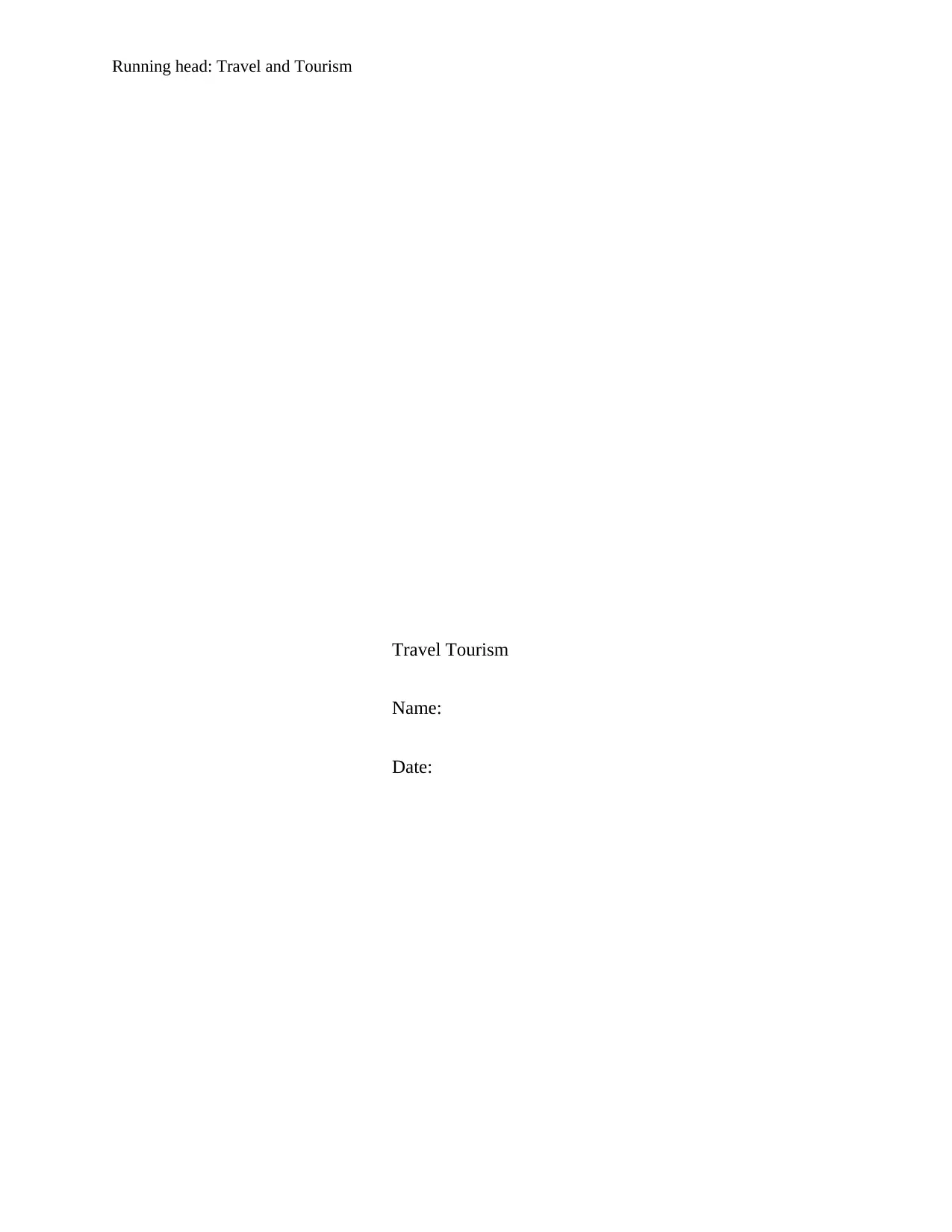
Running head: Travel and Tourism
Travel Tourism
Name:
Date:
Travel Tourism
Name:
Date:
Paraphrase This Document
Need a fresh take? Get an instant paraphrase of this document with our AI Paraphraser
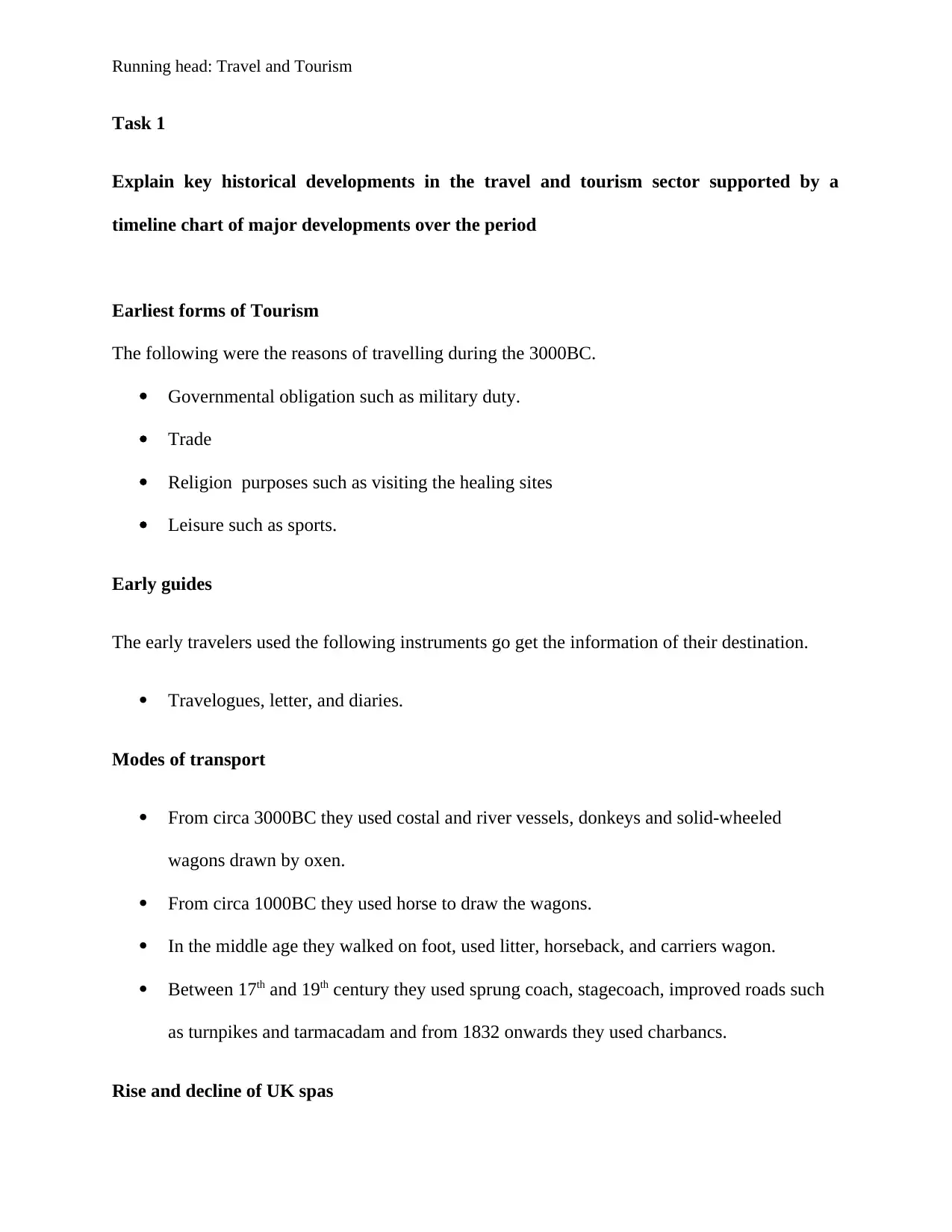
Running head: Travel and Tourism
Task 1
Explain key historical developments in the travel and tourism sector supported by a
timeline chart of major developments over the period
Earliest forms of Tourism
The following were the reasons of travelling during the 3000BC.
Governmental obligation such as military duty.
Trade
Religion purposes such as visiting the healing sites
Leisure such as sports.
Early guides
The early travelers used the following instruments go get the information of their destination.
Travelogues, letter, and diaries.
Modes of transport
From circa 3000BC they used costal and river vessels, donkeys and solid-wheeled
wagons drawn by oxen.
From circa 1000BC they used horse to draw the wagons.
In the middle age they walked on foot, used litter, horseback, and carriers wagon.
Between 17th and 19th century they used sprung coach, stagecoach, improved roads such
as turnpikes and tarmacadam and from 1832 onwards they used charbancs.
Rise and decline of UK spas
Task 1
Explain key historical developments in the travel and tourism sector supported by a
timeline chart of major developments over the period
Earliest forms of Tourism
The following were the reasons of travelling during the 3000BC.
Governmental obligation such as military duty.
Trade
Religion purposes such as visiting the healing sites
Leisure such as sports.
Early guides
The early travelers used the following instruments go get the information of their destination.
Travelogues, letter, and diaries.
Modes of transport
From circa 3000BC they used costal and river vessels, donkeys and solid-wheeled
wagons drawn by oxen.
From circa 1000BC they used horse to draw the wagons.
In the middle age they walked on foot, used litter, horseback, and carriers wagon.
Between 17th and 19th century they used sprung coach, stagecoach, improved roads such
as turnpikes and tarmacadam and from 1832 onwards they used charbancs.
Rise and decline of UK spas
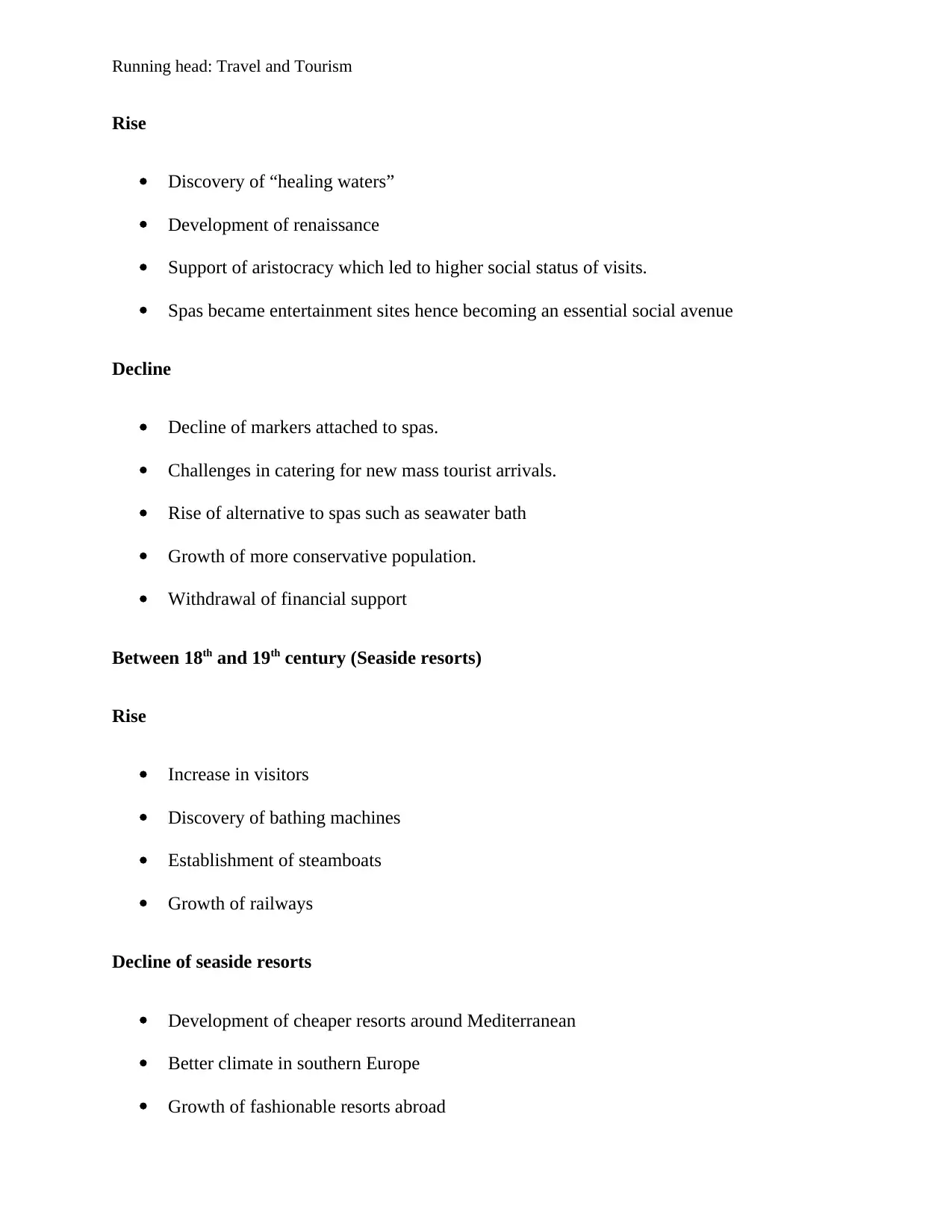
Running head: Travel and Tourism
Rise
Discovery of “healing waters”
Development of renaissance
Support of aristocracy which led to higher social status of visits.
Spas became entertainment sites hence becoming an essential social avenue
Decline
Decline of markers attached to spas.
Challenges in catering for new mass tourist arrivals.
Rise of alternative to spas such as seawater bath
Growth of more conservative population.
Withdrawal of financial support
Between 18th and 19th century (Seaside resorts)
Rise
Increase in visitors
Discovery of bathing machines
Establishment of steamboats
Growth of railways
Decline of seaside resorts
Development of cheaper resorts around Mediterranean
Better climate in southern Europe
Growth of fashionable resorts abroad
Rise
Discovery of “healing waters”
Development of renaissance
Support of aristocracy which led to higher social status of visits.
Spas became entertainment sites hence becoming an essential social avenue
Decline
Decline of markers attached to spas.
Challenges in catering for new mass tourist arrivals.
Rise of alternative to spas such as seawater bath
Growth of more conservative population.
Withdrawal of financial support
Between 18th and 19th century (Seaside resorts)
Rise
Increase in visitors
Discovery of bathing machines
Establishment of steamboats
Growth of railways
Decline of seaside resorts
Development of cheaper resorts around Mediterranean
Better climate in southern Europe
Growth of fashionable resorts abroad
⊘ This is a preview!⊘
Do you want full access?
Subscribe today to unlock all pages.

Trusted by 1+ million students worldwide
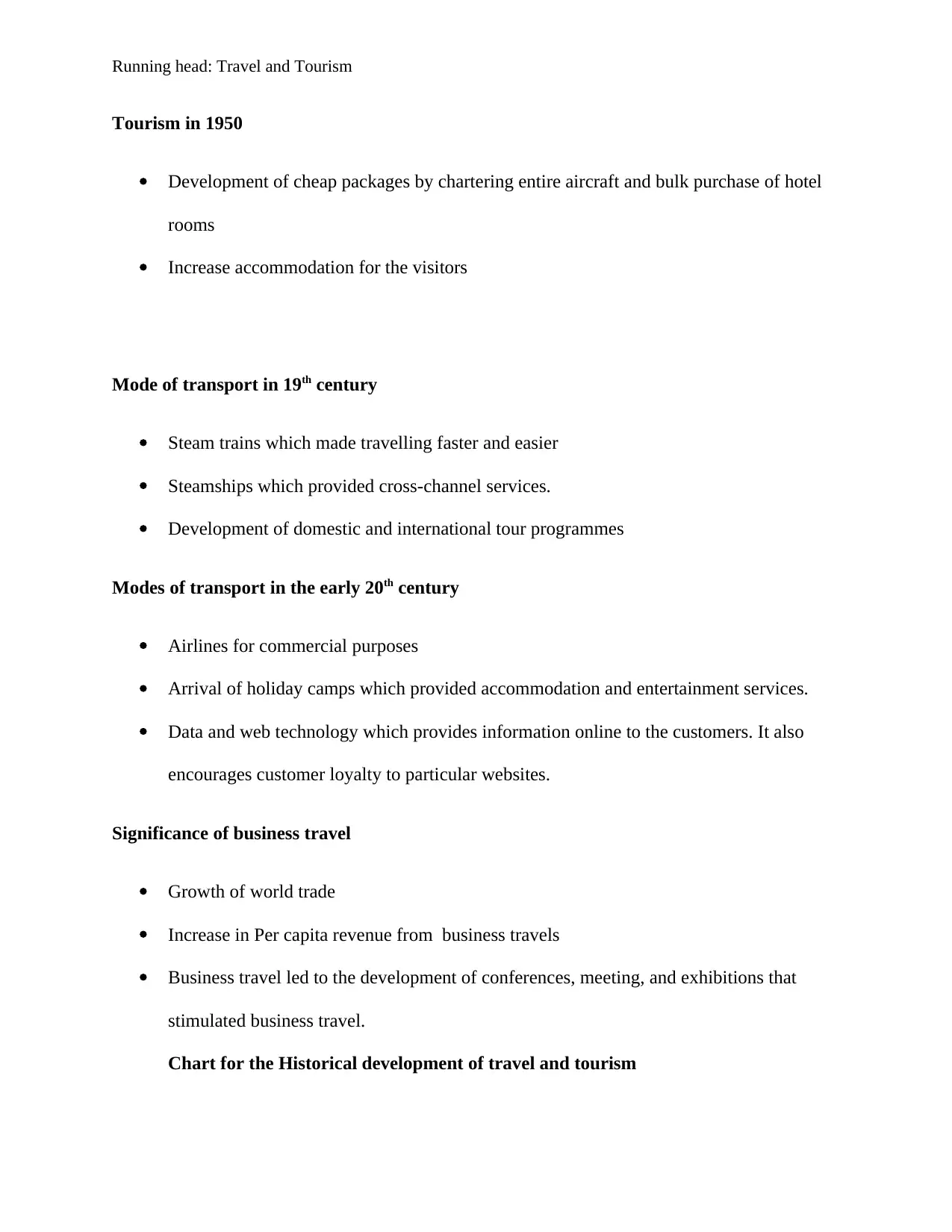
Running head: Travel and Tourism
Tourism in 1950
Development of cheap packages by chartering entire aircraft and bulk purchase of hotel
rooms
Increase accommodation for the visitors
Mode of transport in 19th century
Steam trains which made travelling faster and easier
Steamships which provided cross-channel services.
Development of domestic and international tour programmes
Modes of transport in the early 20th century
Airlines for commercial purposes
Arrival of holiday camps which provided accommodation and entertainment services.
Data and web technology which provides information online to the customers. It also
encourages customer loyalty to particular websites.
Significance of business travel
Growth of world trade
Increase in Per capita revenue from business travels
Business travel led to the development of conferences, meeting, and exhibitions that
stimulated business travel.
Chart for the Historical development of travel and tourism
Tourism in 1950
Development of cheap packages by chartering entire aircraft and bulk purchase of hotel
rooms
Increase accommodation for the visitors
Mode of transport in 19th century
Steam trains which made travelling faster and easier
Steamships which provided cross-channel services.
Development of domestic and international tour programmes
Modes of transport in the early 20th century
Airlines for commercial purposes
Arrival of holiday camps which provided accommodation and entertainment services.
Data and web technology which provides information online to the customers. It also
encourages customer loyalty to particular websites.
Significance of business travel
Growth of world trade
Increase in Per capita revenue from business travels
Business travel led to the development of conferences, meeting, and exhibitions that
stimulated business travel.
Chart for the Historical development of travel and tourism
Paraphrase This Document
Need a fresh take? Get an instant paraphrase of this document with our AI Paraphraser
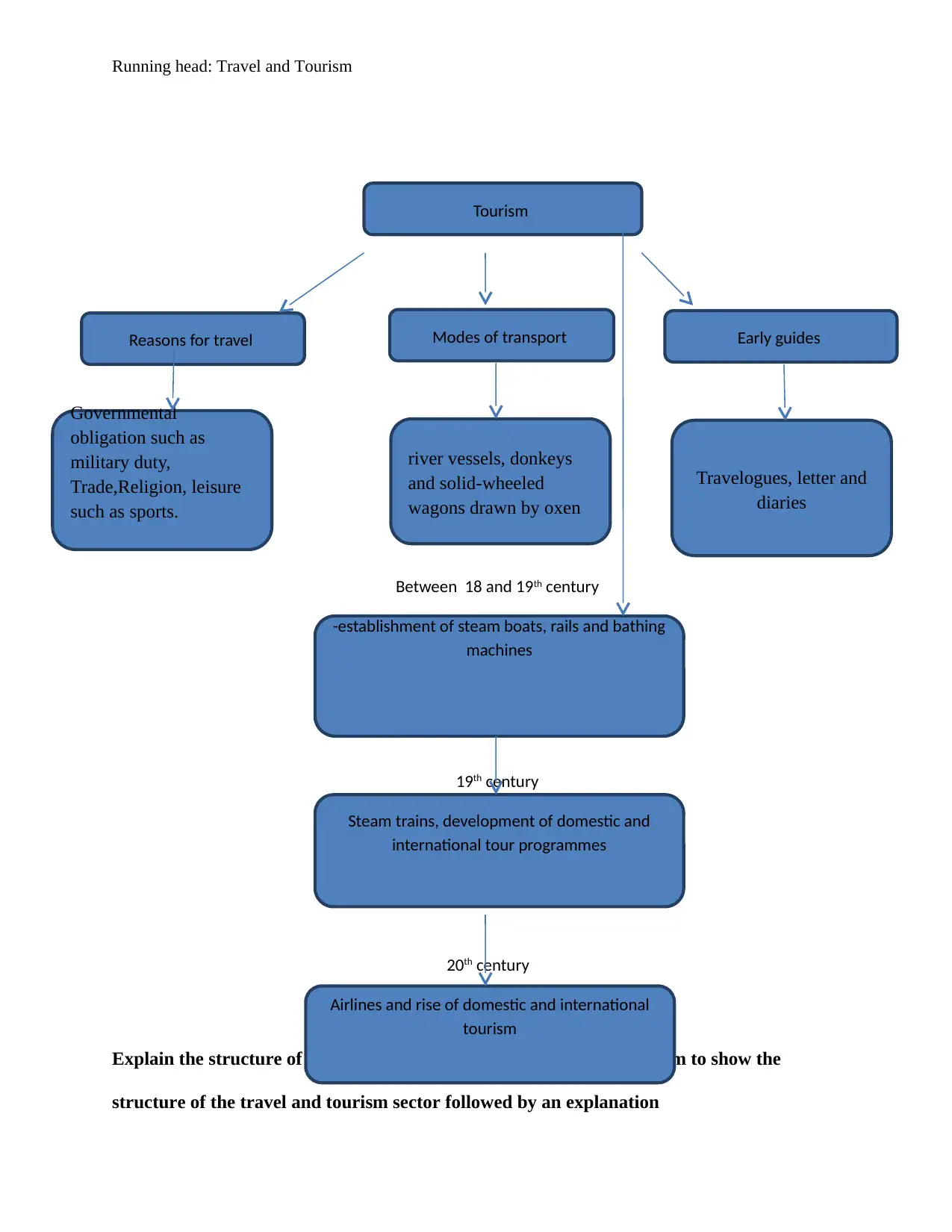
Running head: Travel and Tourism
Explain the structure of the travel and tourism sector. Create a diagram to show the
structure of the travel and tourism sector followed by an explanation
Tourism
Early guidesModes of transportReasons for travel
Governmental
obligation such as
military duty,
Trade,Religion, leisure
such as sports.
Travelogues, letter and
diaries
river vessels, donkeys
and solid-wheeled
wagons drawn by oxen
Between 18 and 19th century
-establishment of steam boats, rails and bathing
machines
19th century
Steam trains, development of domestic and
international tour programmes
20th century
Airlines and rise of domestic and international
tourism
Explain the structure of the travel and tourism sector. Create a diagram to show the
structure of the travel and tourism sector followed by an explanation
Tourism
Early guidesModes of transportReasons for travel
Governmental
obligation such as
military duty,
Trade,Religion, leisure
such as sports.
Travelogues, letter and
diaries
river vessels, donkeys
and solid-wheeled
wagons drawn by oxen
Between 18 and 19th century
-establishment of steam boats, rails and bathing
machines
19th century
Steam trains, development of domestic and
international tour programmes
20th century
Airlines and rise of domestic and international
tourism
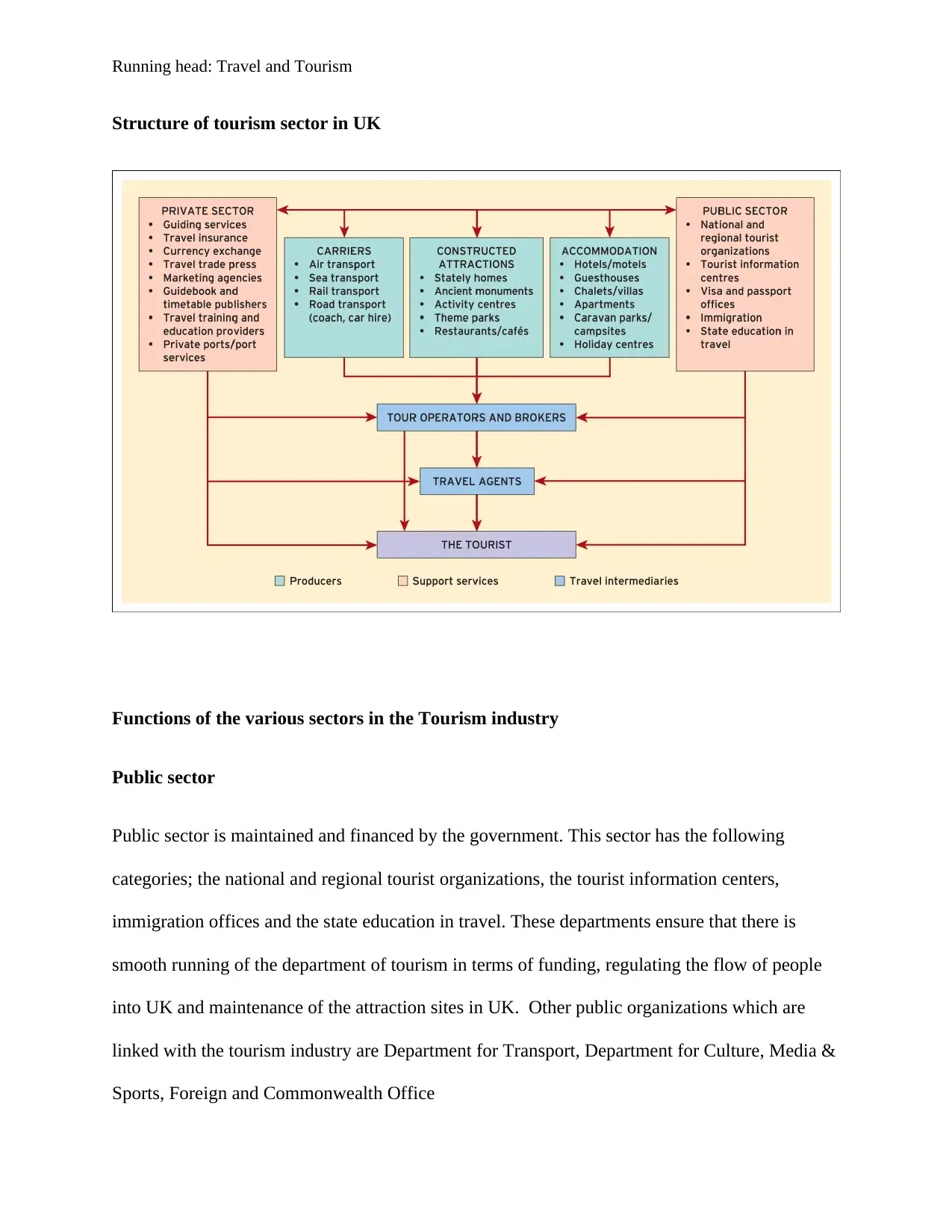
Running head: Travel and Tourism
Structure of tourism sector in UK
Functions of the various sectors in the Tourism industry
Public sector
Public sector is maintained and financed by the government. This sector has the following
categories; the national and regional tourist organizations, the tourist information centers,
immigration offices and the state education in travel. These departments ensure that there is
smooth running of the department of tourism in terms of funding, regulating the flow of people
into UK and maintenance of the attraction sites in UK. Other public organizations which are
linked with the tourism industry are Department for Transport, Department for Culture, Media &
Sports, Foreign and Commonwealth Office
Structure of tourism sector in UK
Functions of the various sectors in the Tourism industry
Public sector
Public sector is maintained and financed by the government. This sector has the following
categories; the national and regional tourist organizations, the tourist information centers,
immigration offices and the state education in travel. These departments ensure that there is
smooth running of the department of tourism in terms of funding, regulating the flow of people
into UK and maintenance of the attraction sites in UK. Other public organizations which are
linked with the tourism industry are Department for Transport, Department for Culture, Media &
Sports, Foreign and Commonwealth Office
⊘ This is a preview!⊘
Do you want full access?
Subscribe today to unlock all pages.

Trusted by 1+ million students worldwide
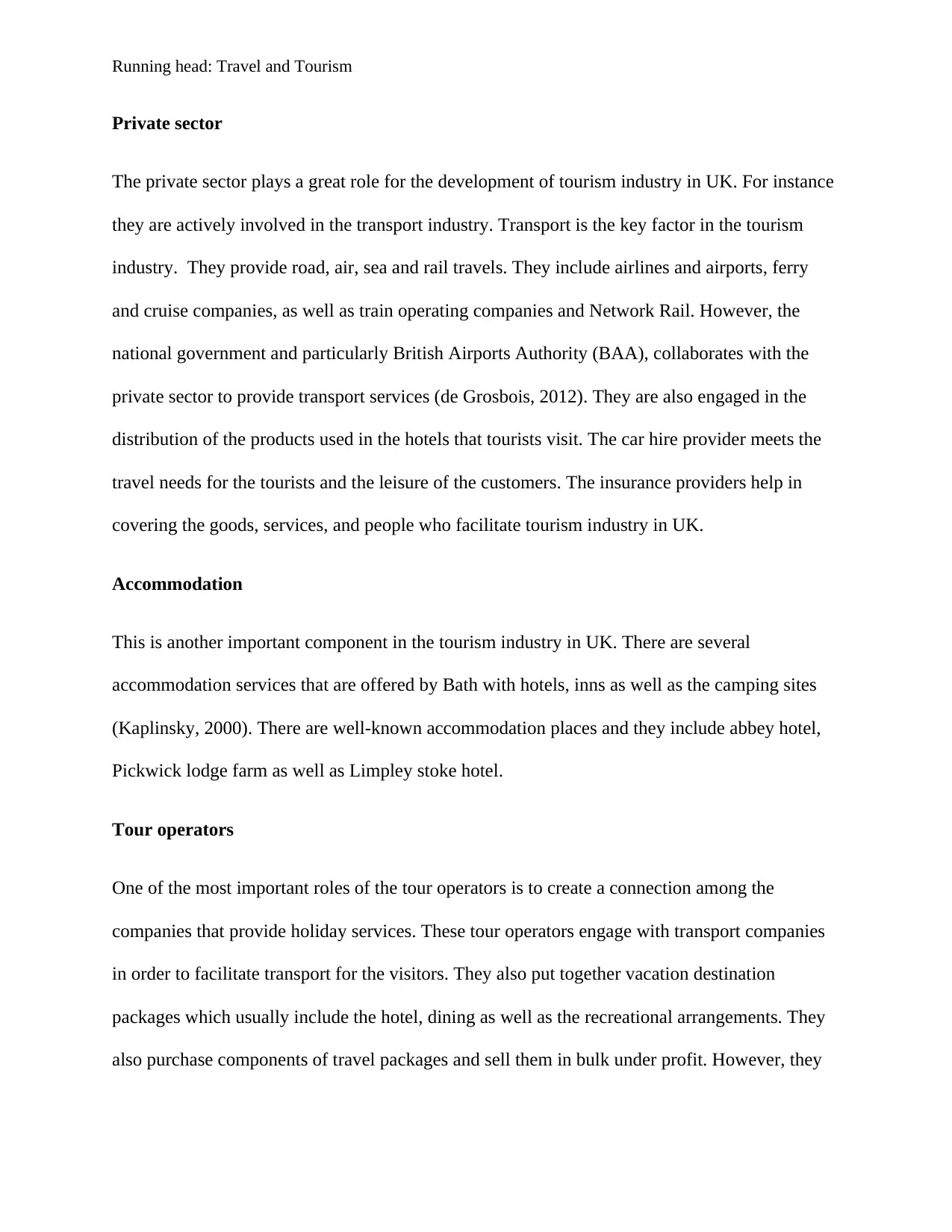
Running head: Travel and Tourism
Private sector
The private sector plays a great role for the development of tourism industry in UK. For instance
they are actively involved in the transport industry. Transport is the key factor in the tourism
industry. They provide road, air, sea and rail travels. They include airlines and airports, ferry
and cruise companies, as well as train operating companies and Network Rail. However, the
national government and particularly British Airports Authority (BAA), collaborates with the
private sector to provide transport services (de Grosbois, 2012). They are also engaged in the
distribution of the products used in the hotels that tourists visit. The car hire provider meets the
travel needs for the tourists and the leisure of the customers. The insurance providers help in
covering the goods, services, and people who facilitate tourism industry in UK.
Accommodation
This is another important component in the tourism industry in UK. There are several
accommodation services that are offered by Bath with hotels, inns as well as the camping sites
(Kaplinsky, 2000). There are well-known accommodation places and they include abbey hotel,
Pickwick lodge farm as well as Limpley stoke hotel.
Tour operators
One of the most important roles of the tour operators is to create a connection among the
companies that provide holiday services. These tour operators engage with transport companies
in order to facilitate transport for the visitors. They also put together vacation destination
packages which usually include the hotel, dining as well as the recreational arrangements. They
also purchase components of travel packages and sell them in bulk under profit. However, they
Private sector
The private sector plays a great role for the development of tourism industry in UK. For instance
they are actively involved in the transport industry. Transport is the key factor in the tourism
industry. They provide road, air, sea and rail travels. They include airlines and airports, ferry
and cruise companies, as well as train operating companies and Network Rail. However, the
national government and particularly British Airports Authority (BAA), collaborates with the
private sector to provide transport services (de Grosbois, 2012). They are also engaged in the
distribution of the products used in the hotels that tourists visit. The car hire provider meets the
travel needs for the tourists and the leisure of the customers. The insurance providers help in
covering the goods, services, and people who facilitate tourism industry in UK.
Accommodation
This is another important component in the tourism industry in UK. There are several
accommodation services that are offered by Bath with hotels, inns as well as the camping sites
(Kaplinsky, 2000). There are well-known accommodation places and they include abbey hotel,
Pickwick lodge farm as well as Limpley stoke hotel.
Tour operators
One of the most important roles of the tour operators is to create a connection among the
companies that provide holiday services. These tour operators engage with transport companies
in order to facilitate transport for the visitors. They also put together vacation destination
packages which usually include the hotel, dining as well as the recreational arrangements. They
also purchase components of travel packages and sell them in bulk under profit. However, they
Paraphrase This Document
Need a fresh take? Get an instant paraphrase of this document with our AI Paraphraser
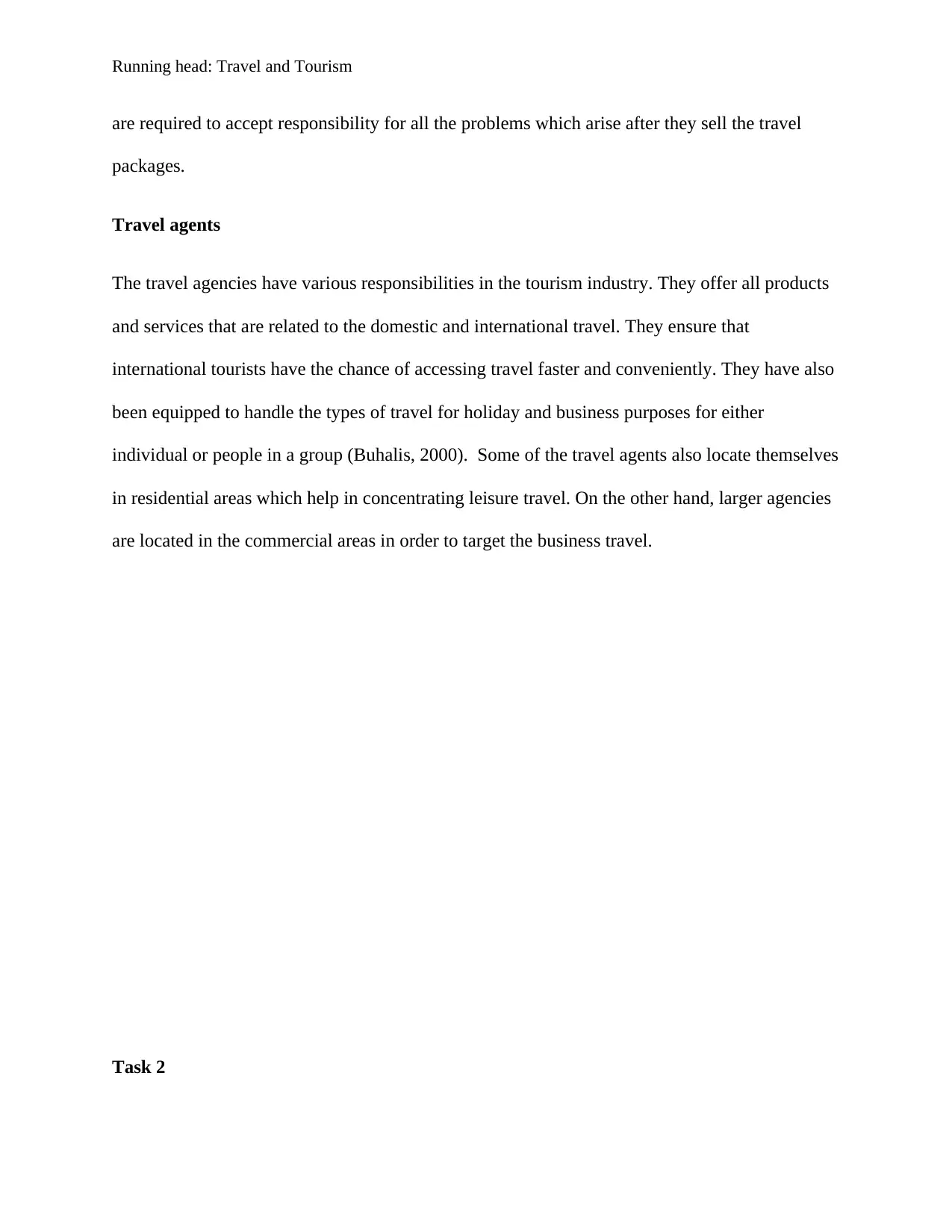
Running head: Travel and Tourism
are required to accept responsibility for all the problems which arise after they sell the travel
packages.
Travel agents
The travel agencies have various responsibilities in the tourism industry. They offer all products
and services that are related to the domestic and international travel. They ensure that
international tourists have the chance of accessing travel faster and conveniently. They have also
been equipped to handle the types of travel for holiday and business purposes for either
individual or people in a group (Buhalis, 2000). Some of the travel agents also locate themselves
in residential areas which help in concentrating leisure travel. On the other hand, larger agencies
are located in the commercial areas in order to target the business travel.
Task 2
are required to accept responsibility for all the problems which arise after they sell the travel
packages.
Travel agents
The travel agencies have various responsibilities in the tourism industry. They offer all products
and services that are related to the domestic and international travel. They ensure that
international tourists have the chance of accessing travel faster and conveniently. They have also
been equipped to handle the types of travel for holiday and business purposes for either
individual or people in a group (Buhalis, 2000). Some of the travel agents also locate themselves
in residential areas which help in concentrating leisure travel. On the other hand, larger agencies
are located in the commercial areas in order to target the business travel.
Task 2
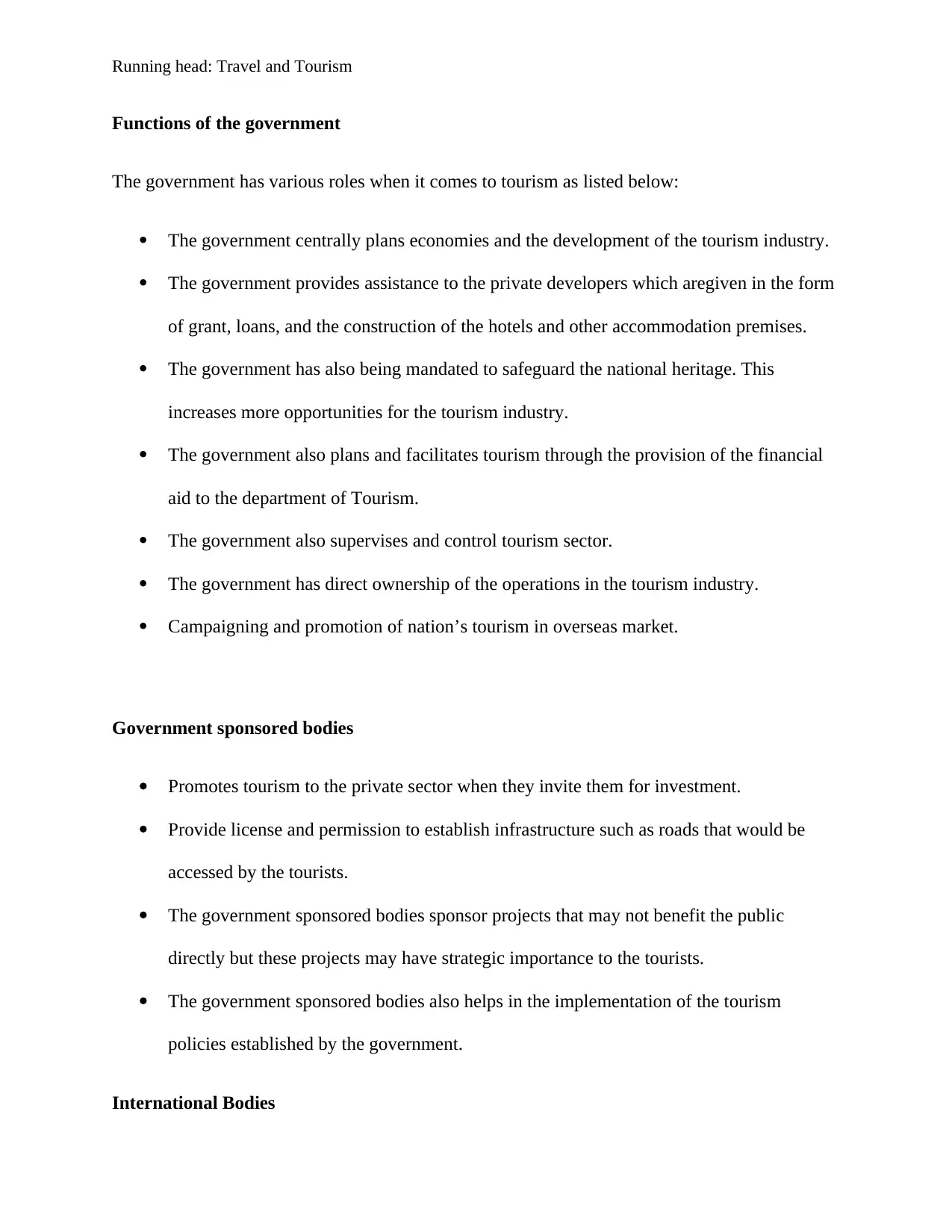
Running head: Travel and Tourism
Functions of the government
The government has various roles when it comes to tourism as listed below:
The government centrally plans economies and the development of the tourism industry.
The government provides assistance to the private developers which aregiven in the form
of grant, loans, and the construction of the hotels and other accommodation premises.
The government has also being mandated to safeguard the national heritage. This
increases more opportunities for the tourism industry.
The government also plans and facilitates tourism through the provision of the financial
aid to the department of Tourism.
The government also supervises and control tourism sector.
The government has direct ownership of the operations in the tourism industry.
Campaigning and promotion of nation’s tourism in overseas market.
Government sponsored bodies
Promotes tourism to the private sector when they invite them for investment.
Provide license and permission to establish infrastructure such as roads that would be
accessed by the tourists.
The government sponsored bodies sponsor projects that may not benefit the public
directly but these projects may have strategic importance to the tourists.
The government sponsored bodies also helps in the implementation of the tourism
policies established by the government.
International Bodies
Functions of the government
The government has various roles when it comes to tourism as listed below:
The government centrally plans economies and the development of the tourism industry.
The government provides assistance to the private developers which aregiven in the form
of grant, loans, and the construction of the hotels and other accommodation premises.
The government has also being mandated to safeguard the national heritage. This
increases more opportunities for the tourism industry.
The government also plans and facilitates tourism through the provision of the financial
aid to the department of Tourism.
The government also supervises and control tourism sector.
The government has direct ownership of the operations in the tourism industry.
Campaigning and promotion of nation’s tourism in overseas market.
Government sponsored bodies
Promotes tourism to the private sector when they invite them for investment.
Provide license and permission to establish infrastructure such as roads that would be
accessed by the tourists.
The government sponsored bodies sponsor projects that may not benefit the public
directly but these projects may have strategic importance to the tourists.
The government sponsored bodies also helps in the implementation of the tourism
policies established by the government.
International Bodies
⊘ This is a preview!⊘
Do you want full access?
Subscribe today to unlock all pages.

Trusted by 1+ million students worldwide
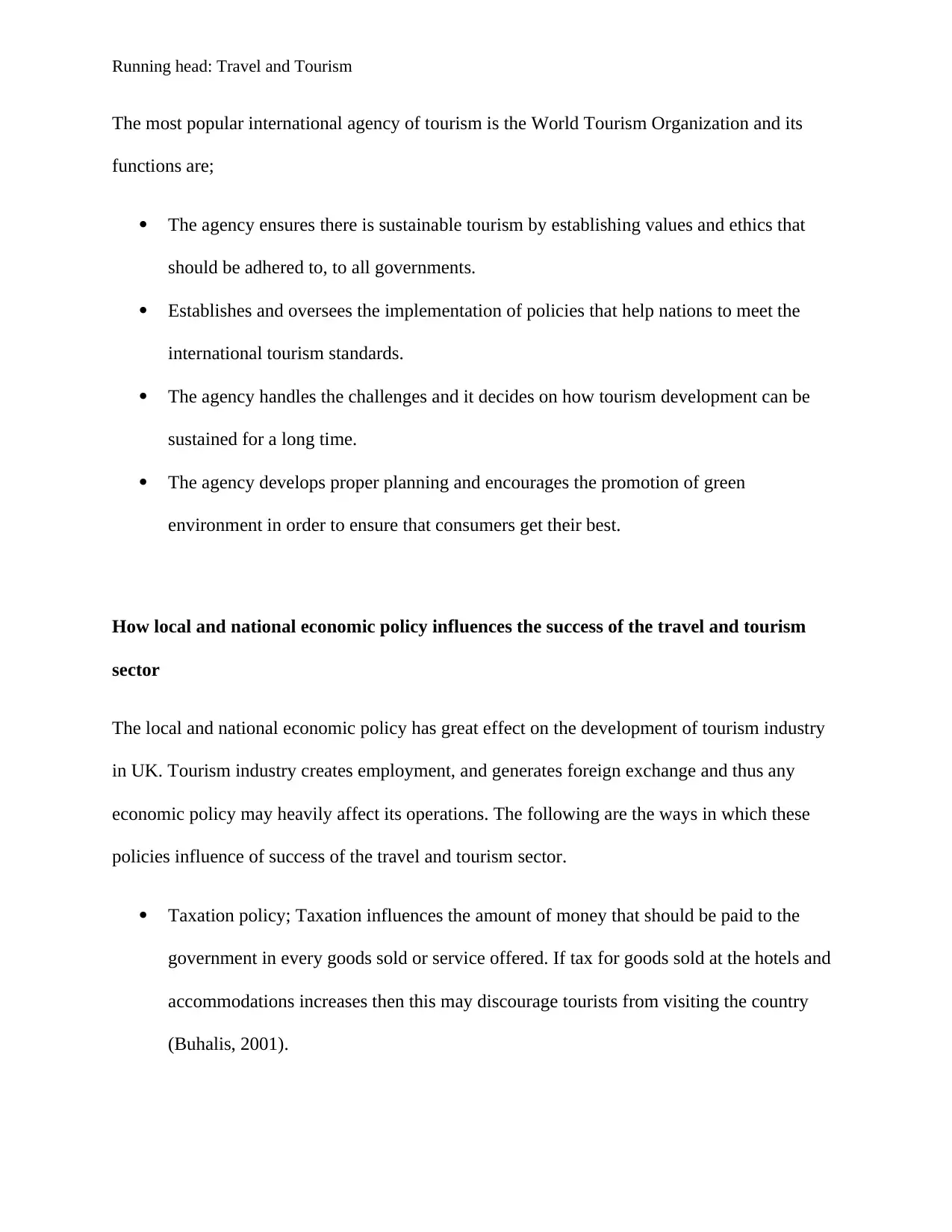
Running head: Travel and Tourism
The most popular international agency of tourism is the World Tourism Organization and its
functions are;
The agency ensures there is sustainable tourism by establishing values and ethics that
should be adhered to, to all governments.
Establishes and oversees the implementation of policies that help nations to meet the
international tourism standards.
The agency handles the challenges and it decides on how tourism development can be
sustained for a long time.
The agency develops proper planning and encourages the promotion of green
environment in order to ensure that consumers get their best.
How local and national economic policy influences the success of the travel and tourism
sector
The local and national economic policy has great effect on the development of tourism industry
in UK. Tourism industry creates employment, and generates foreign exchange and thus any
economic policy may heavily affect its operations. The following are the ways in which these
policies influence of success of the travel and tourism sector.
Taxation policy; Taxation influences the amount of money that should be paid to the
government in every goods sold or service offered. If tax for goods sold at the hotels and
accommodations increases then this may discourage tourists from visiting the country
(Buhalis, 2001).
The most popular international agency of tourism is the World Tourism Organization and its
functions are;
The agency ensures there is sustainable tourism by establishing values and ethics that
should be adhered to, to all governments.
Establishes and oversees the implementation of policies that help nations to meet the
international tourism standards.
The agency handles the challenges and it decides on how tourism development can be
sustained for a long time.
The agency develops proper planning and encourages the promotion of green
environment in order to ensure that consumers get their best.
How local and national economic policy influences the success of the travel and tourism
sector
The local and national economic policy has great effect on the development of tourism industry
in UK. Tourism industry creates employment, and generates foreign exchange and thus any
economic policy may heavily affect its operations. The following are the ways in which these
policies influence of success of the travel and tourism sector.
Taxation policy; Taxation influences the amount of money that should be paid to the
government in every goods sold or service offered. If tax for goods sold at the hotels and
accommodations increases then this may discourage tourists from visiting the country
(Buhalis, 2001).
Paraphrase This Document
Need a fresh take? Get an instant paraphrase of this document with our AI Paraphraser
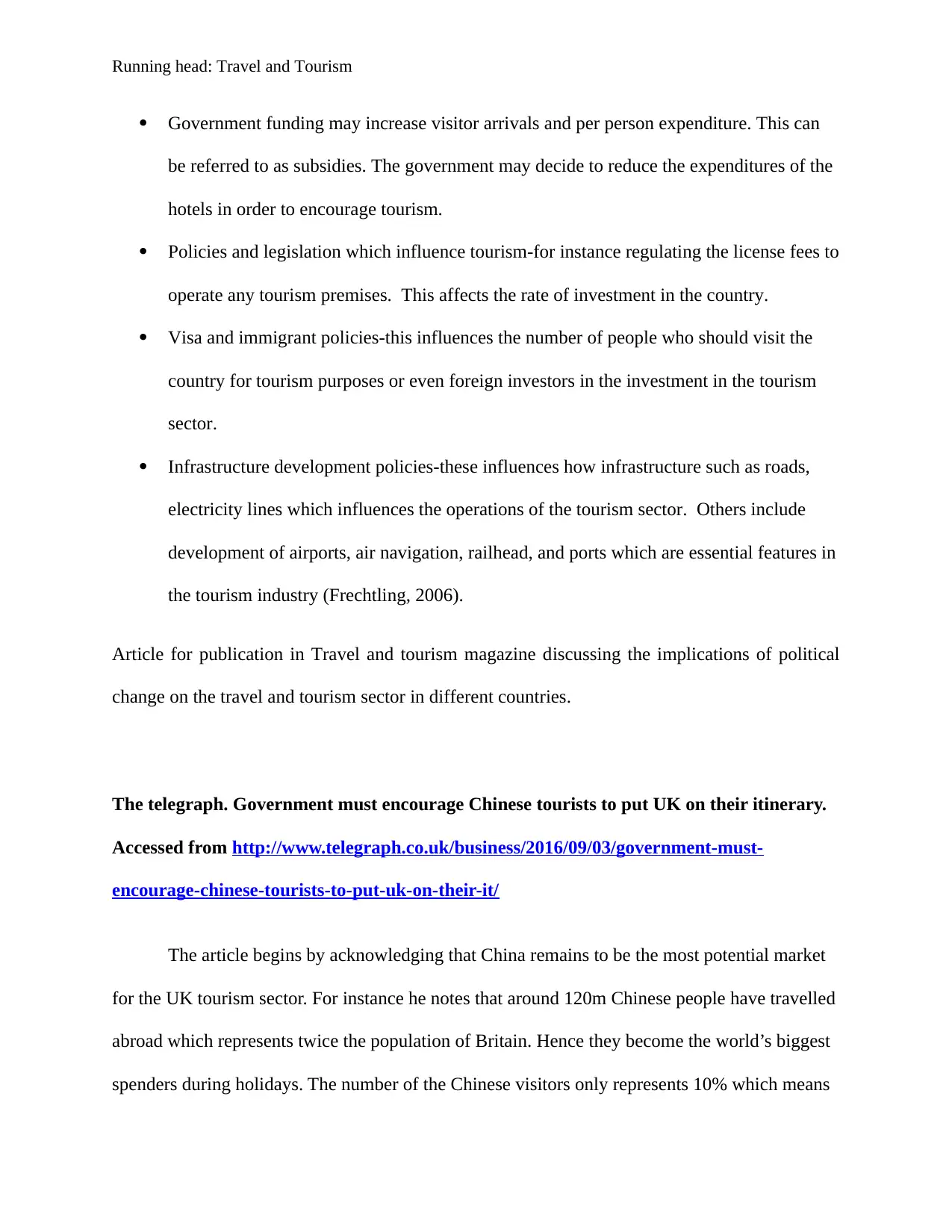
Running head: Travel and Tourism
Government funding may increase visitor arrivals and per person expenditure. This can
be referred to as subsidies. The government may decide to reduce the expenditures of the
hotels in order to encourage tourism.
Policies and legislation which influence tourism-for instance regulating the license fees to
operate any tourism premises. This affects the rate of investment in the country.
Visa and immigrant policies-this influences the number of people who should visit the
country for tourism purposes or even foreign investors in the investment in the tourism
sector.
Infrastructure development policies-these influences how infrastructure such as roads,
electricity lines which influences the operations of the tourism sector. Others include
development of airports, air navigation, railhead, and ports which are essential features in
the tourism industry (Frechtling, 2006).
Article for publication in Travel and tourism magazine discussing the implications of political
change on the travel and tourism sector in different countries.
The telegraph. Government must encourage Chinese tourists to put UK on their itinerary.
Accessed from http://www.telegraph.co.uk/business/2016/09/03/government-must-
encourage-chinese-tourists-to-put-uk-on-their-it/
The article begins by acknowledging that China remains to be the most potential market
for the UK tourism sector. For instance he notes that around 120m Chinese people have travelled
abroad which represents twice the population of Britain. Hence they become the world’s biggest
spenders during holidays. The number of the Chinese visitors only represents 10% which means
Government funding may increase visitor arrivals and per person expenditure. This can
be referred to as subsidies. The government may decide to reduce the expenditures of the
hotels in order to encourage tourism.
Policies and legislation which influence tourism-for instance regulating the license fees to
operate any tourism premises. This affects the rate of investment in the country.
Visa and immigrant policies-this influences the number of people who should visit the
country for tourism purposes or even foreign investors in the investment in the tourism
sector.
Infrastructure development policies-these influences how infrastructure such as roads,
electricity lines which influences the operations of the tourism sector. Others include
development of airports, air navigation, railhead, and ports which are essential features in
the tourism industry (Frechtling, 2006).
Article for publication in Travel and tourism magazine discussing the implications of political
change on the travel and tourism sector in different countries.
The telegraph. Government must encourage Chinese tourists to put UK on their itinerary.
Accessed from http://www.telegraph.co.uk/business/2016/09/03/government-must-
encourage-chinese-tourists-to-put-uk-on-their-it/
The article begins by acknowledging that China remains to be the most potential market
for the UK tourism sector. For instance he notes that around 120m Chinese people have travelled
abroad which represents twice the population of Britain. Hence they become the world’s biggest
spenders during holidays. The number of the Chinese visitors only represents 10% which means
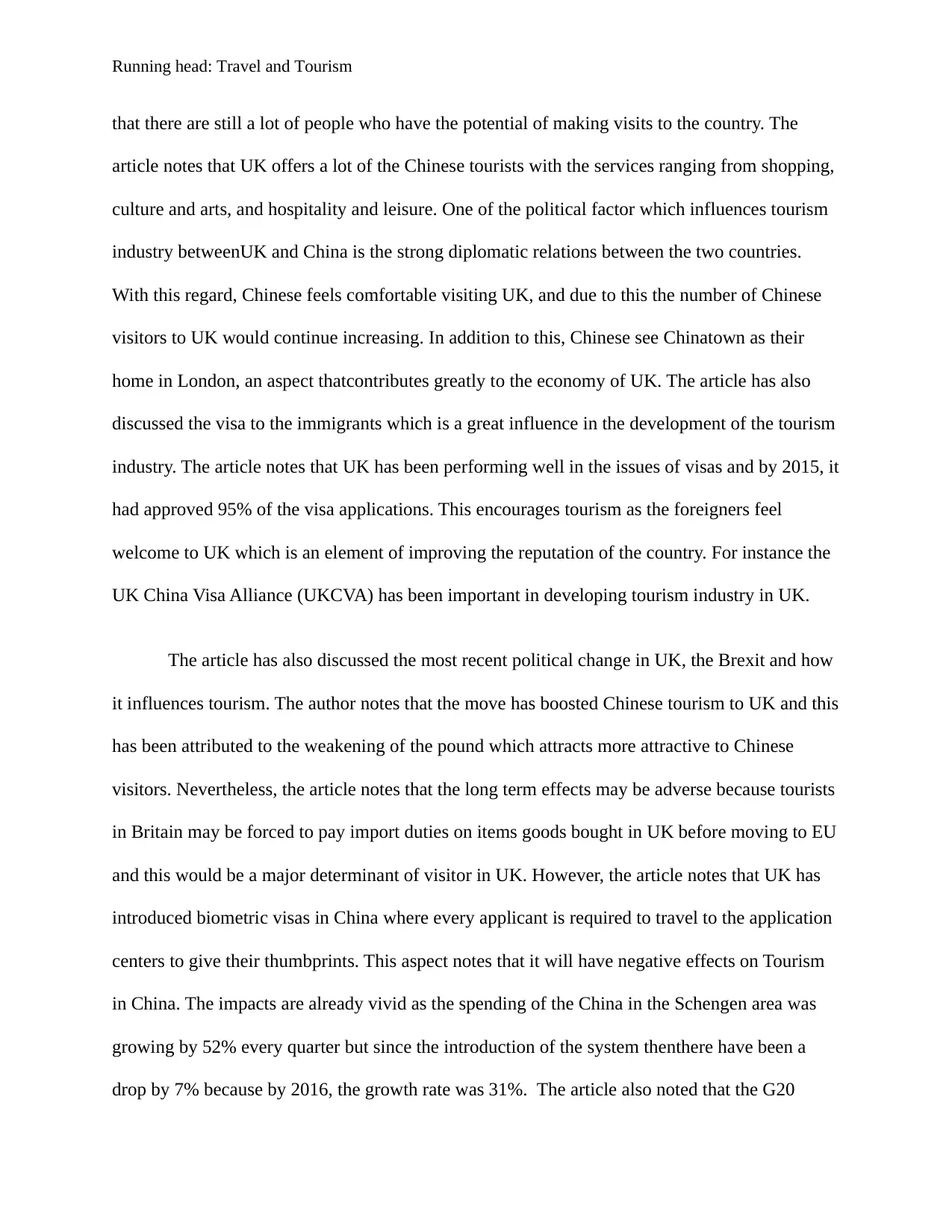
Running head: Travel and Tourism
that there are still a lot of people who have the potential of making visits to the country. The
article notes that UK offers a lot of the Chinese tourists with the services ranging from shopping,
culture and arts, and hospitality and leisure. One of the political factor which influences tourism
industry betweenUK and China is the strong diplomatic relations between the two countries.
With this regard, Chinese feels comfortable visiting UK, and due to this the number of Chinese
visitors to UK would continue increasing. In addition to this, Chinese see Chinatown as their
home in London, an aspect thatcontributes greatly to the economy of UK. The article has also
discussed the visa to the immigrants which is a great influence in the development of the tourism
industry. The article notes that UK has been performing well in the issues of visas and by 2015, it
had approved 95% of the visa applications. This encourages tourism as the foreigners feel
welcome to UK which is an element of improving the reputation of the country. For instance the
UK China Visa Alliance (UKCVA) has been important in developing tourism industry in UK.
The article has also discussed the most recent political change in UK, the Brexit and how
it influences tourism. The author notes that the move has boosted Chinese tourism to UK and this
has been attributed to the weakening of the pound which attracts more attractive to Chinese
visitors. Nevertheless, the article notes that the long term effects may be adverse because tourists
in Britain may be forced to pay import duties on items goods bought in UK before moving to EU
and this would be a major determinant of visitor in UK. However, the article notes that UK has
introduced biometric visas in China where every applicant is required to travel to the application
centers to give their thumbprints. This aspect notes that it will have negative effects on Tourism
in China. The impacts are already vivid as the spending of the China in the Schengen area was
growing by 52% every quarter but since the introduction of the system thenthere have been a
drop by 7% because by 2016, the growth rate was 31%. The article also noted that the G20
that there are still a lot of people who have the potential of making visits to the country. The
article notes that UK offers a lot of the Chinese tourists with the services ranging from shopping,
culture and arts, and hospitality and leisure. One of the political factor which influences tourism
industry betweenUK and China is the strong diplomatic relations between the two countries.
With this regard, Chinese feels comfortable visiting UK, and due to this the number of Chinese
visitors to UK would continue increasing. In addition to this, Chinese see Chinatown as their
home in London, an aspect thatcontributes greatly to the economy of UK. The article has also
discussed the visa to the immigrants which is a great influence in the development of the tourism
industry. The article notes that UK has been performing well in the issues of visas and by 2015, it
had approved 95% of the visa applications. This encourages tourism as the foreigners feel
welcome to UK which is an element of improving the reputation of the country. For instance the
UK China Visa Alliance (UKCVA) has been important in developing tourism industry in UK.
The article has also discussed the most recent political change in UK, the Brexit and how
it influences tourism. The author notes that the move has boosted Chinese tourism to UK and this
has been attributed to the weakening of the pound which attracts more attractive to Chinese
visitors. Nevertheless, the article notes that the long term effects may be adverse because tourists
in Britain may be forced to pay import duties on items goods bought in UK before moving to EU
and this would be a major determinant of visitor in UK. However, the article notes that UK has
introduced biometric visas in China where every applicant is required to travel to the application
centers to give their thumbprints. This aspect notes that it will have negative effects on Tourism
in China. The impacts are already vivid as the spending of the China in the Schengen area was
growing by 52% every quarter but since the introduction of the system thenthere have been a
drop by 7% because by 2016, the growth rate was 31%. The article also noted that the G20
⊘ This is a preview!⊘
Do you want full access?
Subscribe today to unlock all pages.

Trusted by 1+ million students worldwide
1 out of 24
Related Documents
Your All-in-One AI-Powered Toolkit for Academic Success.
+13062052269
info@desklib.com
Available 24*7 on WhatsApp / Email
![[object Object]](/_next/static/media/star-bottom.7253800d.svg)
Unlock your academic potential
Copyright © 2020–2025 A2Z Services. All Rights Reserved. Developed and managed by ZUCOL.




